
|   |

|   |
 e-mail: sunilkothari1933@gmail.com If it is December, it must be Chennai January 4, 2020 Come December and some of us from the Capital plan well in advance to move to Chennai for the 'season' now extending from December to January and at times further extending to February also. Of late, the main reasons are also to escape the Delhi winter with extreme cold and pollution. Chennai weather is far better than what we suffer at Delhi. And it also extends to February. The city is all abuzz with music and whatsApp is bombarded with announcements of several performances, enthusiastic dancers post videos and clog our cell phones. The incessant postings tire one's patience. Social media has become an easy tool for advertisement, though, in a way, it helps one to select in advance what one would like to see and attend! Awakening 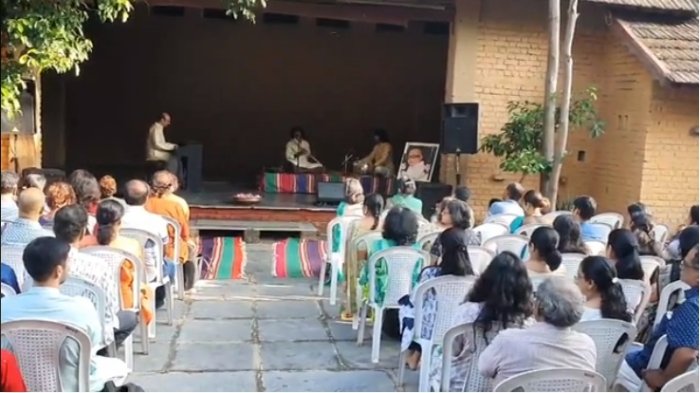 Pravin and Anil are in complete sync playing, the notes from piano and the melody from flute fill the air. Ahir Bhairav raga transports us to another plane. Anita whispers in my ears: 'We now know how Krishna enchanted Gopis with his divine flute!' The association with mythology rings so true. The bhajan with variation Ram ratan dhan payori maine and similar tunes Maiyaa mori mai nahi makhan khayo are spontaneous feelings shared. At the end of the recital, Sadanand Menon announces that this year it will be on 20th December before Xmas - it will be on 20/2020! Very much looking forward to it. All converge in the open ground to greet and chat, relish hot coffee and compare notes for what to attend in coming days. Rama Vaidyanathan, the convener of 39th Natya Kala Conference and Akhila Krishnamurthy of Aalaap, who has also coordinated this morning event are seen with their dancers and participants. Young dancers pose with seniors and friends for photos and I also join them. The season starts with a bang. Mohanapriyan Thavarajah's engaging Bharatanatyam recital 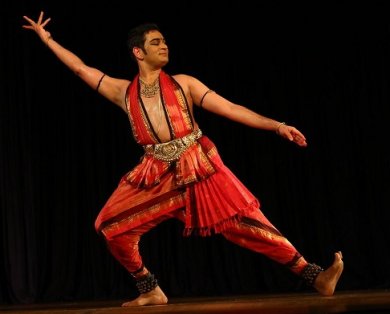 His solo Bharatanatyam performance during the season at Narada Gana Sabha stood out for his mastery over the idiom. His nritta is of Kalakshetra bani further embellished by his innovative approach. His energy is exemplified with force of precision. His choreography is vibrant with athleticism and sensitivity by nuanced expressive elements of storytelling. He succeeds in creating new structures in Bharatanatyam form. Commencing his performance with a medley of Thevarams on Lord Shiva by saints Thirugnana Sambandar, Appar and Sundarar to the music by Dr. Rajkumar Bharathi, choreography by Sheejith Krishna, Mohanapriyan aptly evoked mood of bhakti during the Margazhi month. His choreography of Navarasa Varnam in praise of Goddess Meenakshi composed by Lalgudi Jayaraman was replete with sancharis for each rasa. Parvati's expressions were well captured by him. The rasas found felicitous depiction with appropriate episodes. Some were not known to me and I was delighted to watch them. For instance, bhayanaka when the Lord drank poison after Samudramanthana, and also when Ravana shook mount Kailasa. Also Hasyam when instead of helping devotees in the flood banks of river Vaigai, river King Pandian catches him falling asleep. Shantam was illustrated as goddess bestowing peace on devotees who recited her Namavali. The alternating nritta passages were energetic, the utplavanas perfect and maintaining laya admirable. But the most entertaining choreography by Mohanapriyan was of poet Oothakadu Venkatakavi's Kalinga Nartanam. There is an interesting twist in its depiction. Himself Lord of Dance, Shiva wants to visit Gokul to witness Krishna's dance. He arrives with all his decorations, serpents and lots of ash on his body, vyaghra charma, and knocks on the door of Yashoda. When she opens the door and sees Lord Shiva, she is frightened. Shiva explains who he is and why he has come to see Krishna. He removes the serpents and takes a pleasant form and begs of Yashoda to show Krishna and holds him lovingly. At Shiva's request, Krishna dances for him. These two divinities, their avataras thus juxtaposed, delights Yashoda. There is one more story which Mohanapriyan has added at the suggestion of Aravinth Kumarasamy. Whenever the poet at Guruvayur temple sings songs in praise of Krishna, Lord Krishna as a child comes and sits on his lap, plucking at the poet's heart strings. This unusual treatment in Kalinga Nartana is exquisite. I was reminded of similar pada of Surdas, in which Lord Shiva's visit to Gokul to see Krishna's dance is sung by the poet. Mohanapriyan next presented a padam learnt from Bragha Bessell with Ninda Stuti alankara. The poet takes liberty of using ridicule and tease in the manner in which they bring out greatness of the almighty. In this padam, the poet asks of Lord Shiva: 'How do you cope with all atrocities you had to face with you not having a father or mother? Begging from door to door and being ridiculed?' Humour was also used by Mohanapriyan in an interesting manner. Set to Shanmugapriya raga, this composition of Gopala Krishna Bharathi is a favourite padam of many dancers. The finale with Anantham-Anandam set to Desh raga by Dr. Rajkumar Bharathi saw Mohanapriyan in a joyous mood, his choreography reflecting Anandam. He was accompanied by Hariprasad on vocal, Saikripa Prasanna on nattuvangam, V Vedakrishnaram on mridangam, Easwar Ramakrishnan on violin and T Shashidar on flute. Kumara Sambhavam dance-drama Photos: R Prasana Venkatesh Kalakshetra Foundation began its 69th Annual Arts festival on 20th December beginning with restaging its earliest choreographic work Kumara Sambhavam choreographed by Rukmini Devi and presented in September 1947 soon after we achieved Independence. After the success of Kutrala Kuravanji which she had presented in Vikramaditya Mahotsav in Mumbai in 1944, Kumara Sambhavam was the next venture. Kalidasa's kavya had to be edited and shlokas selected for music and dance. Tiger Varadachari with Ghana raga composed the music for shlokas selected by the scholars and Periya Sarada. The new auditorium at Kalakshetra is a gem. When we enter we are welcomed by young dancers holding plates of chandan, kumkum, sugar and flowers. We are asked to take flower petals and place before statue of Rukmini Devi.The floor is decorated with large kolams, there are sunflower garlands hung, the Nagaswaram musicians are playing auspicious ragas, filling the air, the mood is festive. Displayed on one side of the entrance are books. One of the woman volunteers requests me to see the display and asks me to pose with photo biography of Rukmini Devi which I had edited in 2004 for Athai's centenary. She also informs me that now Kalakshetra publications are available online. Various publications on Rukmini Devi and also old journals of Kalakshetra are available. In another corner is display of Kalamkari and handicrafts woven at Kalakshetra Craft Centre. The entire atmosphere generates auspicious mood. You are gently led to your reserved seat. The cane chairs are comfortable. In front are seated young children on chatai, some accompanied by their elders squatting on the floor. Rukmini Devi loved to see children sit and watch from the front. The stage has exquisite curtain studded with small mirrors like design of Saurashtra chaklas. On left side sit musicians. For Kumara Sambhavam, vocalist Hari Prasad amazed us with his two hours of singing. Of late, screens are placed on either side of the stage for projection of English subtitles to help audience follow the sequences. I am asked to sit next to Guru Sadanam Balakrishnan who has been teaching Kathakali at Kalakshetra. In the front row, seats are reserved for senior Kalakshetra dancers like CV Chandrasekar, Dhananjayans, and Jayalakshmi. Kalakshetra president N. Gopalaswami accompanies the Minister for Culture and Tourism Prahlad Patel and Pushpa Kotru, Asst. secretary Culture, Govt of India. With minimal speeches the minister confesses that he has never seen any place or institution like Kalakshetra.He assures Kalakshetra Foundation that their request for granting Kalakshetra students Degree in place of Diploma will materialize during the course of the year. 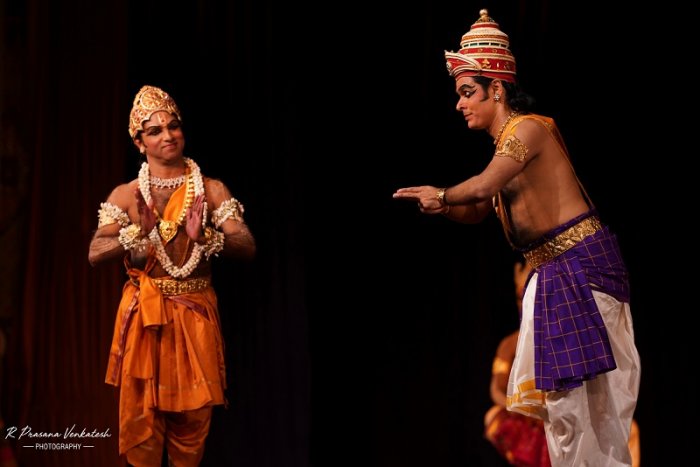 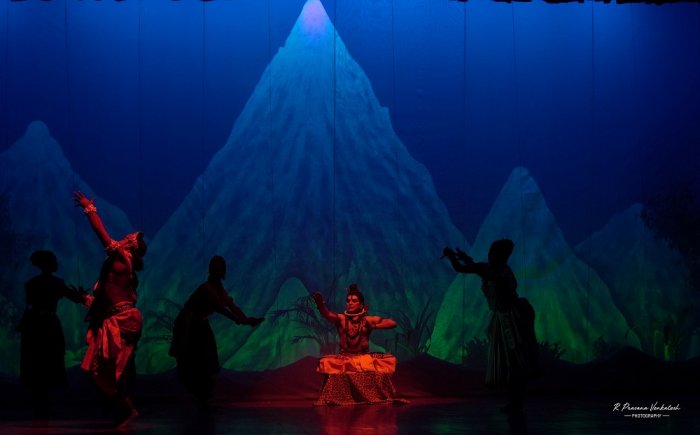 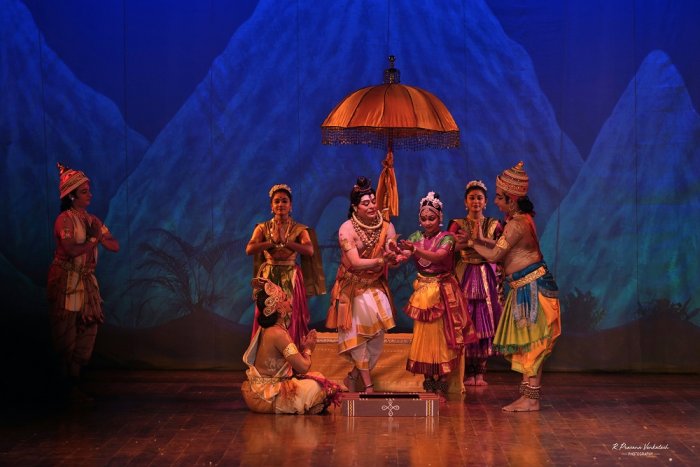 The story unfolds with Indra and another devata approaching Brahma. After Brahma's advice, Indra summons Kamadeva who comes with Rati and obeys command of Indra, coming to the place where Shiva is practicing penance. Parvati is worshipping him. Kamadeva shoots arrows, Lord Shiva's eyes fall on Parvati and he is enamored, but he also gets angry, opens his third eye and turns Kamadeva into ashes. Kalakshetra's early dance-dramas now look simple as with the passage of time, Rukmini Devi has developed the art of Bharatanatyam, her sense of colours, designing costumes, high aesthetics and excellent dance technique, great music, with light design, creating appropriate mood and well trained dancers, but watching it, one at once realizes that this is something unusual. As Aravinth Kumarasamy of Apsaras Arts, Singapore, observes: "The idea of dance-drama is an invention and path breaking creation for Bharatanatyam dance genre. When this work Kumara Sambhavam was conceptualized and presented for the first time way back in 1947, it must have had a huge impact on the audiences and for the pioneers of Carnatic music and Bharatanatyam. Today, dance dramas and dance theaters are the norm and very much in vogue. The performance succeeded in leaving a huge impact on audience present... Tiger Varadachari's compostions to be rendered with intricate sangathis and the variety of talas and complicated eduppus were a challenge for a lesser mortal... The performance is food for thought not only for rasikas and practitioners but also for art historians." How marvelous it would be if one of the senior artistes from Kalakshetra plans to do a Ph.D tracing the development of dance dramas of Rukmini Devi. Exchanging notes with friends and admirers of Kalakshetra, I realized that for me the season has begun with a big gift on my birthday!  Dr. Sunil Kothari is a dance historian, scholar, author and critic, Padma Shri awardee and fellow, Sangeet Natak Akademi. Dance Critics' Association, New York, has honoured him with Lifetime Achievement award. Post your comments Please provide your name and email id when you use the Anonymous profile in the blog to post a comment. All appropriate comments posted with name and email id in the blog will also be featured in the site. |